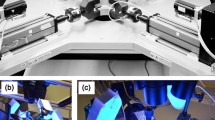Abstract
Background:
Subcritical crack growth can occur in a brittle material when the stress intensity factor is smaller than the fracture toughness if an oxidizing agent (such as water) is present at the crack tip.
Objective:
We present a novel bi-material beam specimen which can measure environmentally assisted crack growth rates. The specimen is “self-loaded” by residual stress and requires no external loading.
Methods:
Two materials with different coefficient of thermal expansion are diffusion bonded at high temperature. After cooling to room temperature a subcritical crack is driven by thermal residual stresses. A finite element model is used to design the specimen geometry in terms of material properties in order to achieve the desired crack tip driving force.
Results:
The specimen is designed so that the crack driving force decreases as the crack extends, thus enabling the measurement of the crack velocity versus driving force relationship with a single test. The method is demonstrated by measuring slow crack growth data in soda lime silicate glass and validated by comparison to previously published data.
Conclusions:
The self-loaded nature of the specimen makes it ideal for measuring the very low crack velocities needed to predict brittle failure at long lifetimes.









Similar content being viewed by others
References
Freiman SW (1984) Effects of chemical environments on slow crack growth in glasses and ceramics. J Geophys Res 89(B6):4072–4076
Frieman SW, Widerhorn SM, Mecholsky JJJ (2009) Environmentally enhanced fracture of glass: a historical perspective. J Am Ceram Soc 92(7):1371–1382
Wiederhorn S (1967) Influence of water vapor on crack propagation in soda-lime glass. J Am Ceram Soc 50(8):407–414
Wiederhorn SM (1968) Moisture assisted crack growth in ceramics. Int J Fract Mech 4(2):171–177
Wiederhorn SM, Bolz LH (1970) Stress corrrosion and static fatigue of glass. J Am Ceram Soc 53(10):543–548
Cognard J (1986) Use of the wedge test to estimate the lifetime of an adhesive joint in an aggressive environment. Int J Adhes Adhes 6(4):215–220
Tandon R, Newton CS, Monroe SL, Glass SJ, Roth CJ (2007) Sub-critical crack growth behavior of a low-temperature co-fired ceramic. J Am Ceram Soc 90(5):1527–1533
Cook RF, Lawn BR, Anstis GR (1982) Fatigue analysis of brittle materials using indentation flaws. J of Mat Sci 17:1108–1116
Cook RF (2015) Multi-scale effects in the strength of ceramics. J Am Ceram Soc 98(10):2933–2947
Kuczynski GC (1949) Study of the sintering of glass. J App Phys 20:1160–1163
Suo Z, Hutchinson JW (1989) Steady-state cracking in brittle substrates beneath adherent films. Int J Solids Struct 25(11):1337–1353
Sandia National Laboratories, Sierra/solidmechanics User’s Guide 4th Edition (2015)
Consultants, Fracture Analysis, Inc, FRANC3d Reference Manual 7th Edition (2016)
Hutchinson JW (1992) Mixed mode cracking in layered materials. Adv in Appl Mech 29:63–191
Goldstein RV, Salganik RL (1974) Brittle fracture of solids with arbitrary cracks. Int J Fract 10:507–523
Erdogan F, Sih GC (1963) On the crack extension in plates under plane loading and transverse shear. J Basic Eng-T ASME 85:516–527
Freiman SW, White GS, Fuller JER (1985) Environmentally enhanced crack growth in soda-lime glass. J Am Ceram Soc 68(3):108–112
Grutzik SJ, Reedy ED (2016) Crack path selection in thermally loaded borosilicate/steel bibeam specimen, Society for Experimental Mechanics. Springer
Guin J, Wiederhorn SM (2003) Crack growth threshold in soda lime silicate glass: role of hold-time. J Non-Cryst Solids 316: 12–20
Acknowledgments
The authors thank Matthew Brake, Michaela Negus, Diane Peebles, Jim Redmond, and Dennis Croessmann of Sandia National Laboratories for organization and support of the Nonlinear Mechanics and Dynamics (NOMAD) Institute. The authors also gratefully acknowledge support from Fracture Analysis Consultants, Inc. for donating a summer license of FRANC3D for use at the NOMAD Institute. Sandia National Laboratories is a multi-mission laboratory managed and operated by National Technology and Engineering Solutions of Sandia, LLC., a wholly owned subsidiary of Honeywell International, Inc., for the U.S. Department of Energy’s National Nuclear Security Administration under contract DE-NA0003525. The authors declare that they have no conflicts of interest.
Author information
Authors and Affiliations
Corresponding author
Ethics declarations
Conflict of interests
The authors do not have any conflicts of interest to disclose and this work did not involve human or animal participants.
Additional information
Publisher’s Note
Springer Nature remains neutral with regard to jurisdictional claims in published maps and institutional affiliations.
This paper describes objective technical results and analysis. Any subjective views or opinions that might be expressed in the paper do not necessarily represent the views of the U.S. Department of Energy or the United States Government.
Rights and permissions
About this article
Cite this article
Grutzik, S., Aduloju, S., Truster, T. et al. Residually Stressed Bimaterial Beam Specimen for Measuring Environmentally Assisted Crack Growth. Exp Mech 61, 411–418 (2021). https://doi.org/10.1007/s11340-020-00659-5
Received:
Accepted:
Published:
Issue Date:
DOI: https://doi.org/10.1007/s11340-020-00659-5




